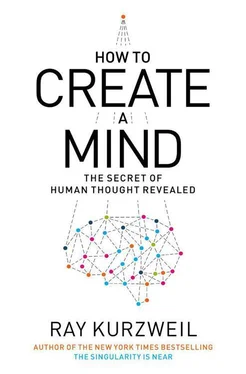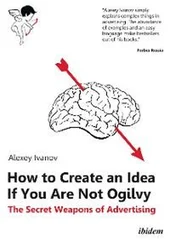The mammalian brain has a distinct aptitude not found in any other class of animal. We are capable of hierarchical thinking, of understanding a structure composed of diverse elements arranged in a pattern, representing that arrangement with a symbol, and then using that symbol as an element in a yet more elaborate configuration. This capability takes place in a brain structure called the neocortex, which in humans has achieved a threshold of sophistication and capacity such that we are able to call these patterns ideas . Through an unending recursive process we are capable of building ideas that are ever more complex. We call this vast array of recursively linked ideas knowledge . Only Homo sapiens have a knowledge base that itself evolves, grows exponentially, and is passed down from one generation to another.
Our brains gave rise to yet another level of abstraction, in that we have used the intelligence of our brains plus one other enabling factor, an opposable appendage—the thumb—to manipulate the environment to build tools. These tools represented a new form of evolution, as neurology gave rise to technology. It is only because of our tools that our knowledge base has been able to grow without limit.
Our first invention was the story: spoken language that enabled us to represent ideas with distinct utterances. With the subsequent invention of written language we developed distinct shapes to symbolize our ideas. Libraries of written language vastly extended the ability of our unaided brains to retain and extend our knowledge base of recursively structured ideas.
There is some debate as to whether other species, such as chimpanzees, have the ability to express hierarchical ideas in language. Chimps are capable of learning a limited set of sign language symbols, which they can use to communicate with human trainers. It is clear, however, that there are distinct limits to the complexity of the knowledge structures with which chimps are capable of dealing. The sentences that they can express are limited to specific simple noun-verb sequences and are not capable of the indefinite expansion of complexity characteristic of humans. For an entertaining example of the complexity of human-generated language, just read one of the spectacular multipage-length sentences in a Gabriel García Márquez story or novel—his six-page story “The Last Voyage of the Ghost” is a single sentence and works quite well in both Spanish and the English translation. 1
The primary idea in my three previous books on technology ( The Age of Intelligent Machines , written in the 1980s and published in 1989; The Age of Spiritual Machines , written in the mid- to late 1990s and published in 1999; and The Singularity Is Near , written in the early 2000s and published in 2005) is that an evolutionary process inherently accelerates (as a result of its increasing levels of abstraction) and that its products grow exponentially in complexity and capability. I call this phenomenon the law of accelerating returns (LOAR), and it pertains to both biological and technological evolution. The most dramatic example of the LOAR is the remarkably predictable exponential growth in the capacity and price/performance of information technologies. The evolutionary process of technology led invariably to the computer, which has in turn enabled a vast expansion of our knowledge base, permitting extensive links from one area of knowledge to another. The Web is itself a powerful and apt example of the ability of a hierarchical system to encompass a vast array of knowledge while preserving its inherent structure. The world itself is inherently hierarchical—trees contain branches; branches contain leaves; leaves contain veins. Buildings contain floors; floors contain rooms; rooms contain doorways, windows, walls, and floors.
We have also developed tools that are now enabling us to understand our own biology in precise information terms. We are rapidly reverse-engineering the information processes that underlie biology, including that of our brains. We now possess the object code of life in the form of the human genome, an achievement that was itself an outstanding example of exponential growth, in that the amount of genetic data the world has sequenced has approximately doubled every year for the past twenty years. 2 We now have the ability to simulate on computers how sequences of base pairs give rise to sequences of amino acids that fold up into three-dimensional proteins, from which all of biology is constructed. The complexity of proteins for which we can simulate protein folding has been steadily increasing as computational resources continue to grow exponentially. 3 We can also simulate how proteins interact with one another in an intricate three-dimensional dance of atomic forces. Our growing understanding of biology is one important facet of discovering the intelligent secrets that evolution has bestowed on us and then using these biologically inspired paradigms to create ever more intelligent technology.
There is now a grand project under way involving many thousands of scientists and engineers working to understand the best example we have of an intelligent process: the human brain. It is arguably the most important effort in the history of the human-machine civilization. In The Singularity Is Near I made the case that one corollary of the law of accelerating returns is that other intelligent species are likely not to exist. To summarize the argument, if they existed we would have noticed them, given the relatively brief time that elapses between a civilization’s possessing crude technology (consider that in 1850 the fastest way to send nationwide information was the Pony Express) to its possessing technology that can transcend its own planet. 4 From this perspective, reverse-engineering the human brain may be regarded as the most important project in the universe.
The goal of the project is to understand precisely how the human brain works, and then to use these revealed methods to better understand ourselves, to fix the brain when needed, and—most relevant to the subject of this book—to create even more intelligent machines. Keep in mind that greatly amplifying a natural phenomenon is precisely what engineering is capable of doing. As an example, consider the rather subtle phenomenon of Bernoulli’s principle, which states that there is slightly less air pressure over a moving curved surface than over a moving flat one. The mathematics of how Bernoulli’s principle produces wing lift is still not yet fully settled among scientists, yet engineering has taken this delicate insight, focused its powers, and created the entire world of aviation.
In this book I present a thesis I call the pattern recognition theory of mind (PRTM), which, I argue, describes the basic algorithm of the neocortex (the region of the brain responsible for perception, memory, and critical thinking). In the chapters ahead I describe how recent neuroscience research, as well as our own thought experiments, leads to the inescapable conclusion that this method is used consistently across the neocortex. The implication of the PRTM combined with the LOAR is that we will be able to engineer these principles to vastly extend the powers of our own intelligence.
Indeed this process is already well under way. There are hundreds of tasks and activities formerly the sole province of human intelligence that can now be conducted by computers, usually with greater precision and at a vastly greater scale. Every time you send an e-mail or connect a cell phone call, intelligent algorithms optimally route the information. Obtain an electrocardiogram, and it comes back with a computer diagnosis that rivals that of doctors. The same is true for blood cell images. Intelligent algorithms automatically detect credit card fraud, fly and land airplanes, guide intelligent weapons systems, help design products with intelligent computer-aided design, keep track of just-in-time inventory levels, assemble products in robotic factories, and play games such as chess and even the subtle game of Go at master levels.
Читать дальше












